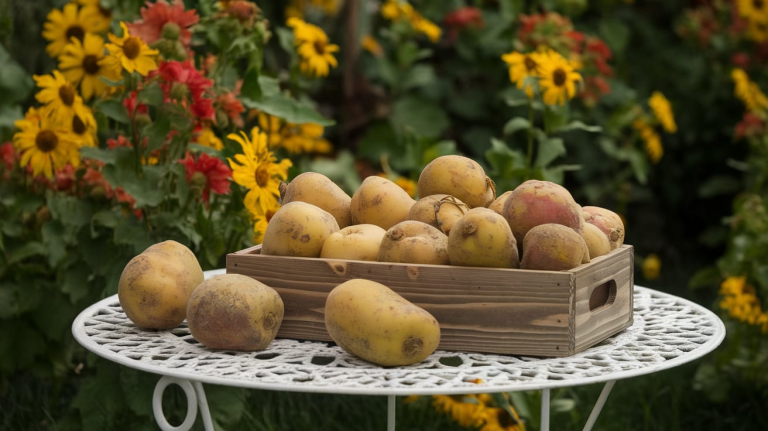Potatoes have long been a staple in diets worldwide, cherished for their versatility, nutritional value, and satisfying taste. But what happens when you buy in bulk or harvest them from your garden? Knowing how to store potatoes properly can help you keep them fresh for months.
Poor storage can lead to sprouting, spoilage, and waste, but with the right conditions, potatoes can be preserved in their taste and quality. This guide will show you simple methods for storing potatoes long-term.
From temperature and humidity to the best containers, you’ll learn everything you need to keep your potatoes fresh and ready to use. With just a few steps, you can extend the shelf life of your potatoes and enjoy them for longer.
Understanding the Importance of Proper Potato Storage
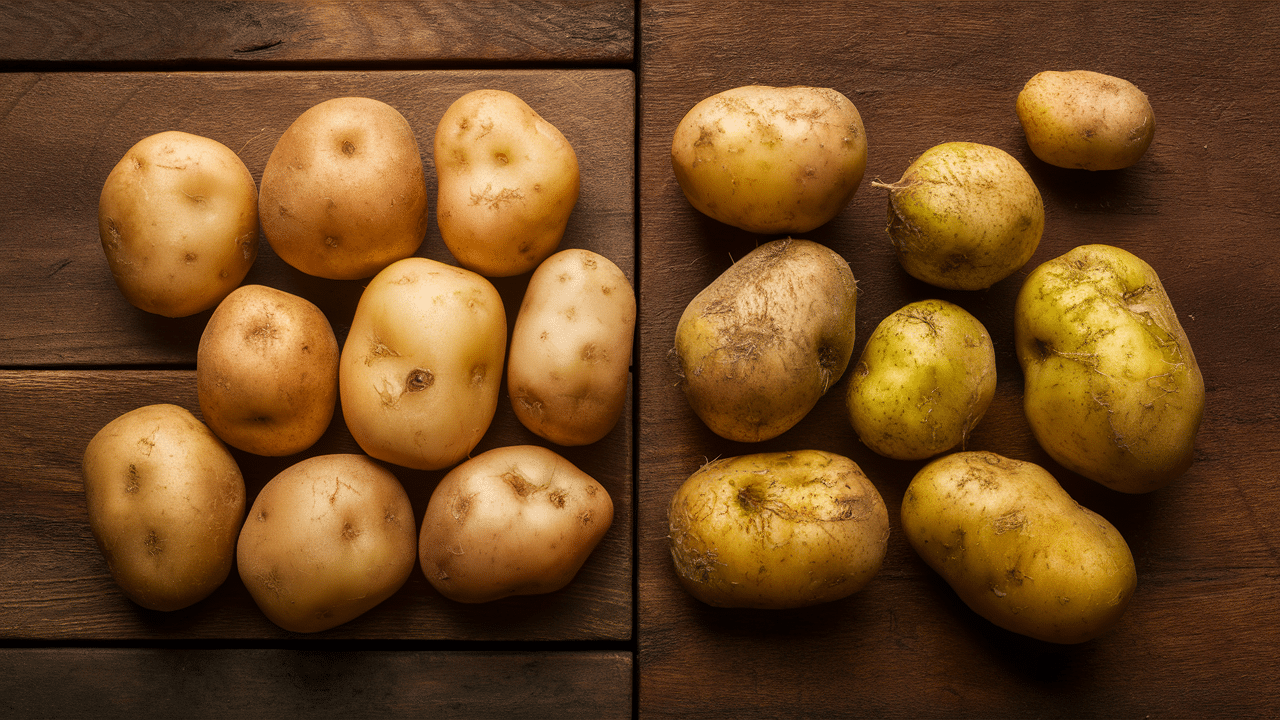
Proper storage of potatoes is not merely about prolonging their shelf life; it’s about preserving their quality, nutritional content, and safety. When stored incorrectly, potatoes can develop harmful compounds like solanine, especially when they turn green or sprout.
Consuming such potatoes can lead to gastrointestinal discomfort and other health issues. Moreover, improper storage can result in significant food waste, impacting both the environment and your budget.
By understanding and implementing effective storage techniques, you can ensure that your potatoes remain safe to eat, retain their nutritional benefits, and reduce unnecessary waste.
Selecting the Right Potato Varieties for Storage
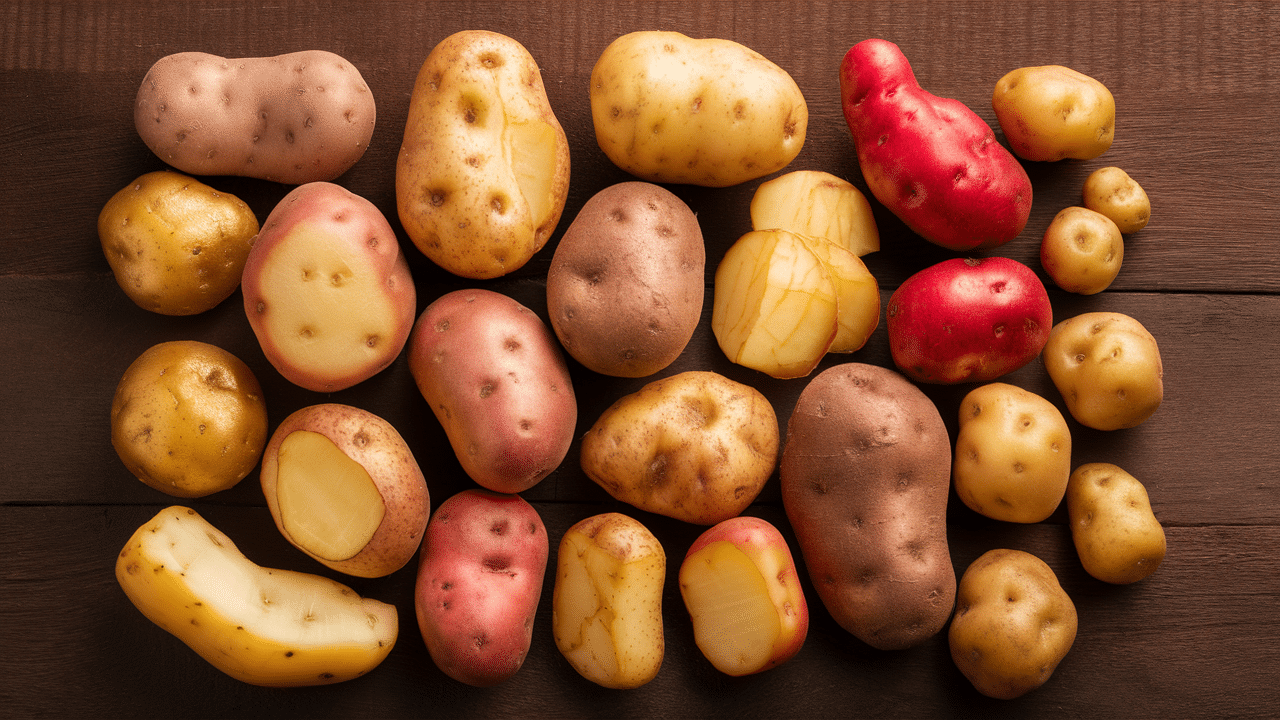
Choosing the right type of potato makes a big difference in how long they last in storage. Some varieties naturally keep longer due to their thicker skin and lower moisture content.
1. Choose Potatoes with Thick Skins
Thick-skinned potatoes are better at keeping out moisture and air, which helps slow down spoilage.
- Potatoes like Russet Burbank or Kennebec are known for having tough, dry skins that act like a natural wrapper.
- Thin-skinned varieties like red potatoes may feel smooth and look nice, but they don’t hold up as long in storage. They’re more likely to bruise or rot if stored for weeks or months.
2. Look for Low-Moisture Varieties
Potatoes with less moisture inside last longer because they’re less likely to rot or grow mold.
- Dry, starchy potatoes such as Russets are a great example. These are perfect for long-term storage and still cook up beautifully for baked potatoes or mashed dishes.
- In contrast, waxy potatoes like Red Bliss or New Potatoes hold more water and should be eaten fresh or soon after harvest.
3. Pick Disease-Resistant Varieties
Some potatoes are bred to fight off common diseases that could ruin your stored batch.
- Kennebec and Elba are two storage-friendly varieties that resist blight and scab—both common problems in potatoes.
- Choosing these types helps keep your whole storage pile safer and healthier for months to come.
4. Consider Local Growing Conditions
If you grow your own potatoes, check which varieties do well in your area’s soil and climate.
- Local seed companies or garden centers often suggest varieties that thrive nearby and are proven to store well in your region.
- For example, in cooler climates, Gold Rush or Caribou Russet may be good picks. In warmer areas, Red Pontiac might do better but won’t store as long.
5. Grow or Buy “Maincrop” Potatoes
Potatoes come in three main harvest times: early, second early, and main crop. For long-term storage, maincrop potatoes are the best option.
- Maincrop potatoes grow for a longer season, which gives them thicker skin and better storage life.
- Yukon Gold, Russet Burbank, and Kennebec are all popular maincrop choices.
6. Avoid Damaged or Soft Potatoes at Purchase
Even the best variety won’t store well if it’s already bruised, cut, or soft.
- Whether you’re buying from a store or harvesting your own, inspect each potato closely.
- Only keep potatoes that are firm and blemish-free for storage. Eat the rest soon or freeze them.
Harvesting Potatoes for Optimal Storage
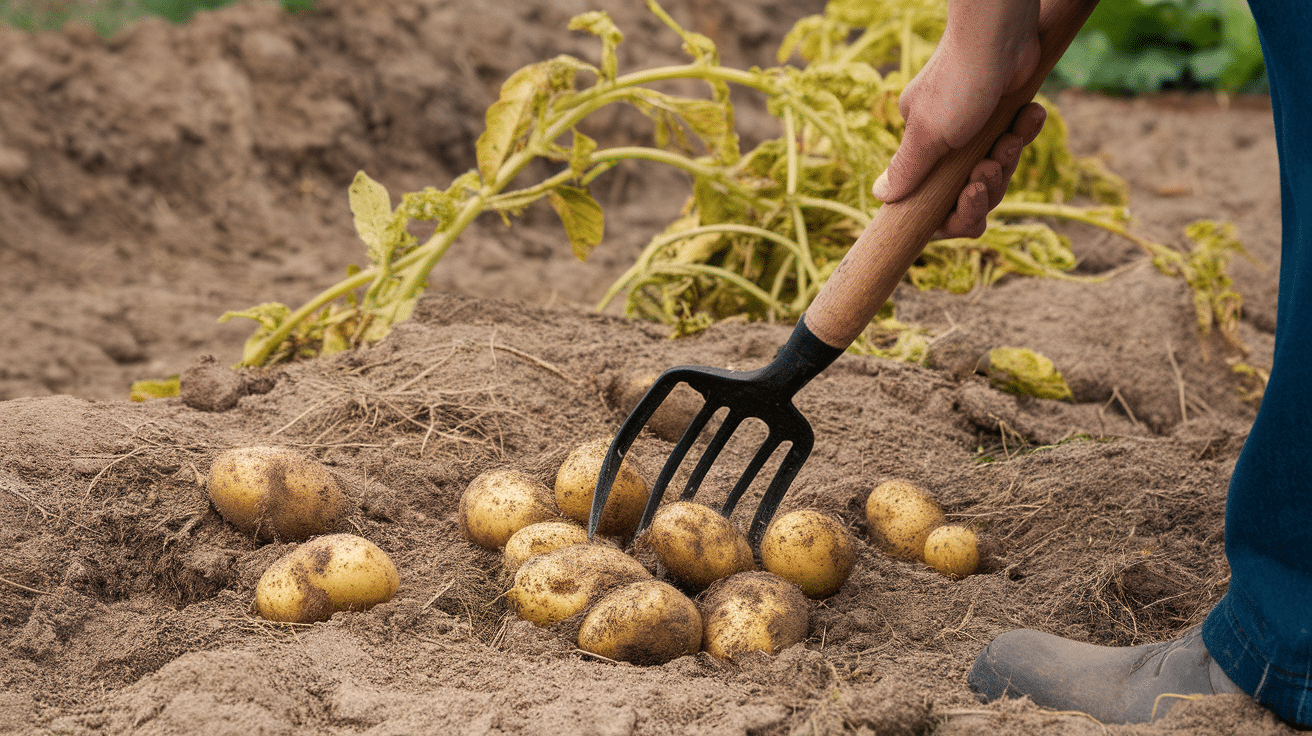
The way you harvest your potatoes matters to make them last in storage. If you pick them too early or handle them roughly, they can spoil quickly. Follow these detailed steps for a better harvest and longer shelf life.
1. Wait Until the Vines Die Back
The first sign that potatoes are ready to harvest is when the green leafy tops, or vines, start turning yellow and dry out. This means the potatoes have finished growing, and the skins are starting to toughen.
If you dig them up while the vines are still green, the potatoes might be too soft and their skins too thin. These won’t store well and may rot early.
2. Let the Potatoes Sit Underground for a Week or Two
After the vines die, let the potatoes stay in the soil for another 1 to 2 weeks. This gives the skins more time to thicken, which protects them in storage.
Just make sure the soil isn’t too wet and that there’s no risk of frost. If it rains heavily, it’s better to dig them up sooner to avoid rot.
3. Use a Garden Fork to Dig Carefully
When it’s time to harvest, don’t use a shovel, which can easily cut or stab the potatoes. A garden fork is a gentler option.
Push it into the ground about 12 inches from the plant and lift the soil slowly. This helps you dig up the whole plant without damaging the potatoes.
4. Handle Each Potato with Care
Once you dig them up, handle each potato gently. Don’t toss them into a bucket or bang them against each other. Even small bruises or cuts can lead to spoilage later. Set them gently in a box or basket. Try not to stack them too deep, so they don’t crush each other.
5. Don’t Wash the Potatoes
It might seem like a good idea to wash off the dirt, but that can lead to problems. Washing adds moisture, and moisture leads to mold.
Just let the potatoes dry in a shaded, airy spot for a few hours. After they dry, brush off any loose soil with your hand or a soft brush.
6. Sort Out Damaged or Bad Potatoes
Before you store them, go through your pile and take out any potatoes that are soft, cut, bruised, or green. These won’t store well and could cause others nearby to spoil too. Use these up quickly instead of storing them long-term.
Curing Potatoes to Enhance Shelf Life
Curing is a key step that many people skip, but it makes a big difference when it comes to storing potatoes for a long time. It helps toughen the skins and heal small cuts, which protects the potatoes from rotting in storage.
What Is Curing and Why It Matters
Curing means letting freshly harvested potatoes sit in the right conditions for a short time before long-term storage. During this process, the skins dry and hardens, and any small scrapes or scratches on the surface heal over. Without curing, potatoes are much more likely to rot or grow mold in storage.
The Best Curing Conditions
To cure your potatoes, place them in a dark, cool place with good airflow and high humidity. The best temperature range is between 50°F and 60°F (10°C to 15°C), with humidity around 85% to 95%.
If the temperature stays within that range, you can cure them in a shed, garage, or basement. Lay the potatoes in a single layer on a screen, shelf, or cardboard surface—just make sure they’re not touching too much. Keep them out of direct sunlight.
How Long Should You Cure Potatoes
Cure the potatoes for 10 to 14 days. Check on them every few days to make sure none are rotting. After two weeks, the skins should feel firm and dry. At this point, they’re ready to be moved into long-term storage.
Sort Again Before Storing
After curing, go through the potatoes one more time. If any have developed soft spots or signs of rot, remove them. Only the healthiest potatoes should go into your storage bins.
Preparing Potatoes for Storage
Before storing potatoes, a thorough inspection is necessary. Sort through the batch and remove any that show signs of damage, disease, or rot.
Even a single spoiled potato can affect the surrounding ones, leading to a domino effect of spoilage. It’s also advisable to sort potatoes by size. Larger potatoes tend to have a longer storage life than smaller ones.
By grouping them accordingly, you can use the smaller potatoes first and extend the overall usability of your stock.
Ideal Storage Conditions for Potatoes
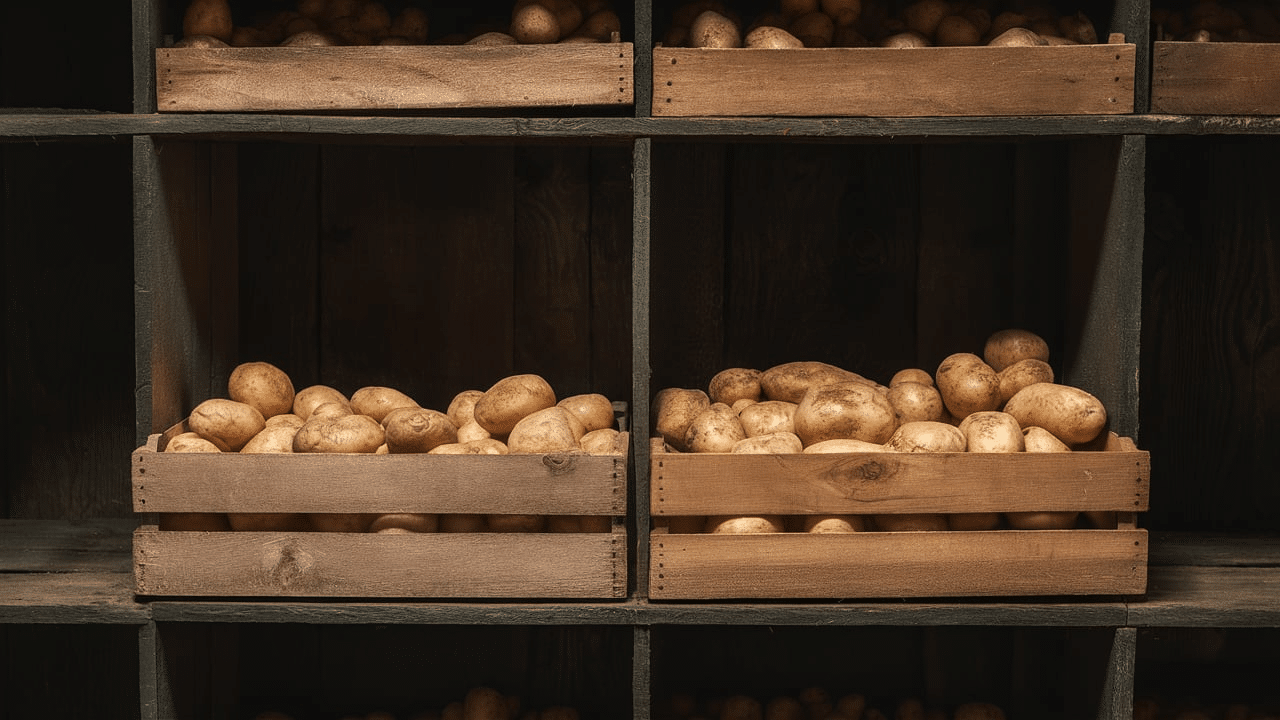
Once your potatoes are harvested, cured, and sorted, it’s time to store them properly. Good storage conditions can help them last for several months without spoiling.
Keep the Storage Area Cool
Potatoes last longest in cool temperatures, ideally between 45°F to 50°F (7°C to 10°C). If it’s too cold (like in a fridge), the starches can turn to sugar, which changes the flavor and texture. If it’s too warm, the potatoes may start sprouting or rotting.
Use a Dark Place
Light causes potatoes to turn green. That green part contains a toxin called solanine, which can make you sick if eaten in large amounts. Always store potatoes in a dark spot, like a basement, pantry, or covered bin. If you’re using crates or baskets, cover them with a cloth or newspaper to block the light.
Maintain Good Airflow
Potatoes need fresh air to breathe. Poor air circulation can lead to moisture buildup and mold. Avoid sealing them in plastic bags. Use breathable containers like:
- Burlap sacks
- Mesh bags
- Wooden crates
- Cardboard boxes with holes
Leave some space between containers so that air can move around freely.
Keep Humidity High, but Not Wet
Potatoes like high humidity, around 90%. This prevents them from drying out and shriveling. However, you also need to keep things dry enough to stop mold. A well-ventilated basement or root cellar usually has the right balance.
If your space is dry, you can add a damp cloth nearby (not touching the potatoes) or use a humidifier to raise the humidity.
Store Away from Other Produce
Potatoes should not be stored near onions, apples, or bananas. These foods give off gases that make potatoes sprout faster. Keep them in a separate area so they don’t spoil each other.
Check on Them Regularly
Even in the best conditions, potatoes can still go bad. Every couple of weeks, inspect your stored potatoes. Look for signs of:
- Sprouts
- Soft spots
- Mold
- Wrinkled skins
Remove any problem potatoes right away to stop the rot from spreading to others.
Selecting Appropriate Storage Containers
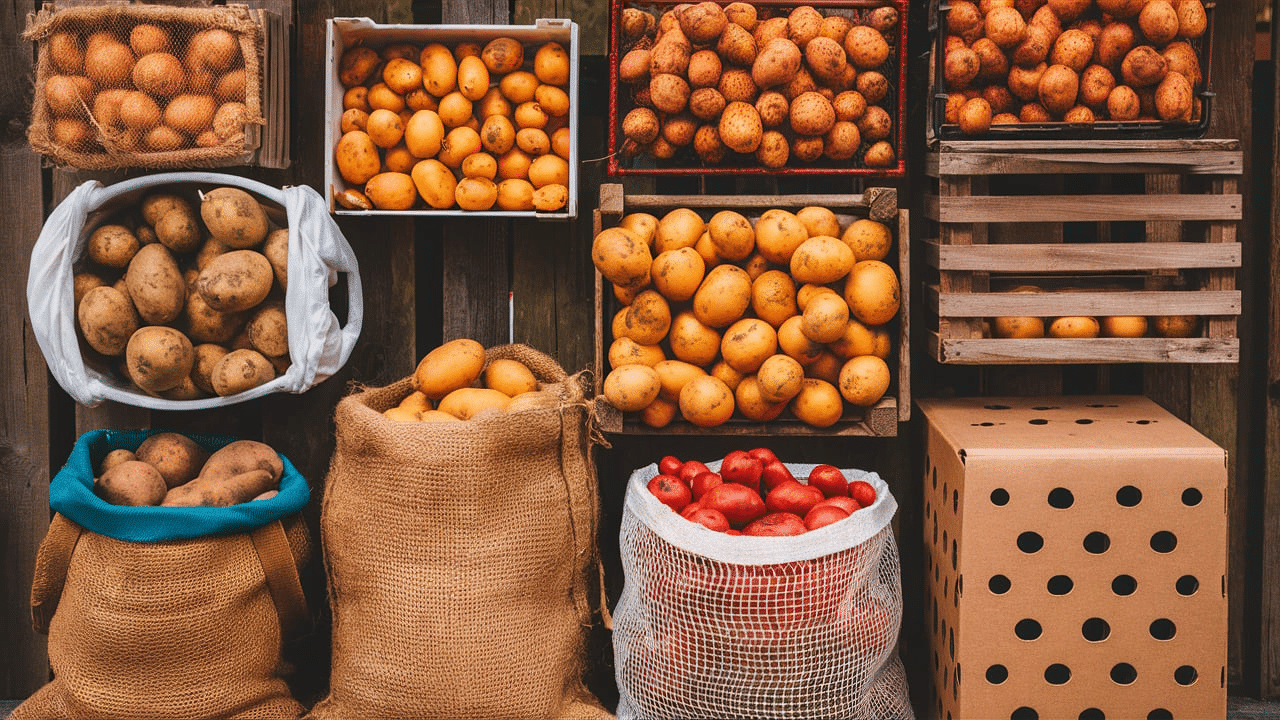
Even with perfect curing and ideal storage conditions, the wrong container can ruin your whole batch. It’s important to pick containers that protect the potatoes while letting them breathe.
1. Use Breathable Materials
Potatoes need airflow to stay dry and fresh. The best storage containers are made from materials that let air move around easily. These include:
- Burlap sacks
- Mesh produce bags
- Wooden crates
- Cardboard boxes with holes punched in the sides
Avoid plastic bags or sealed bins—they trap moisture and create the perfect conditions for mold and rot.
2. Don’t Overfill the Containers
Don’t pile your potatoes too high or pack them too tightly. If they’re stacked too deep, the weight can bruise the ones on the bottom. Fill your container only halfway or about two layers deep. If you have more potatoes, split them into separate containers.
3. Keep Containers Off the Ground
Where you place your containers matters, too. Set them on shelves, pallets, or even bricks to lift them off the cold, damp floor. This improves airflow and helps prevent moisture from building up underneath.
Long-Term Storage Methods (Without a Root Cellar)
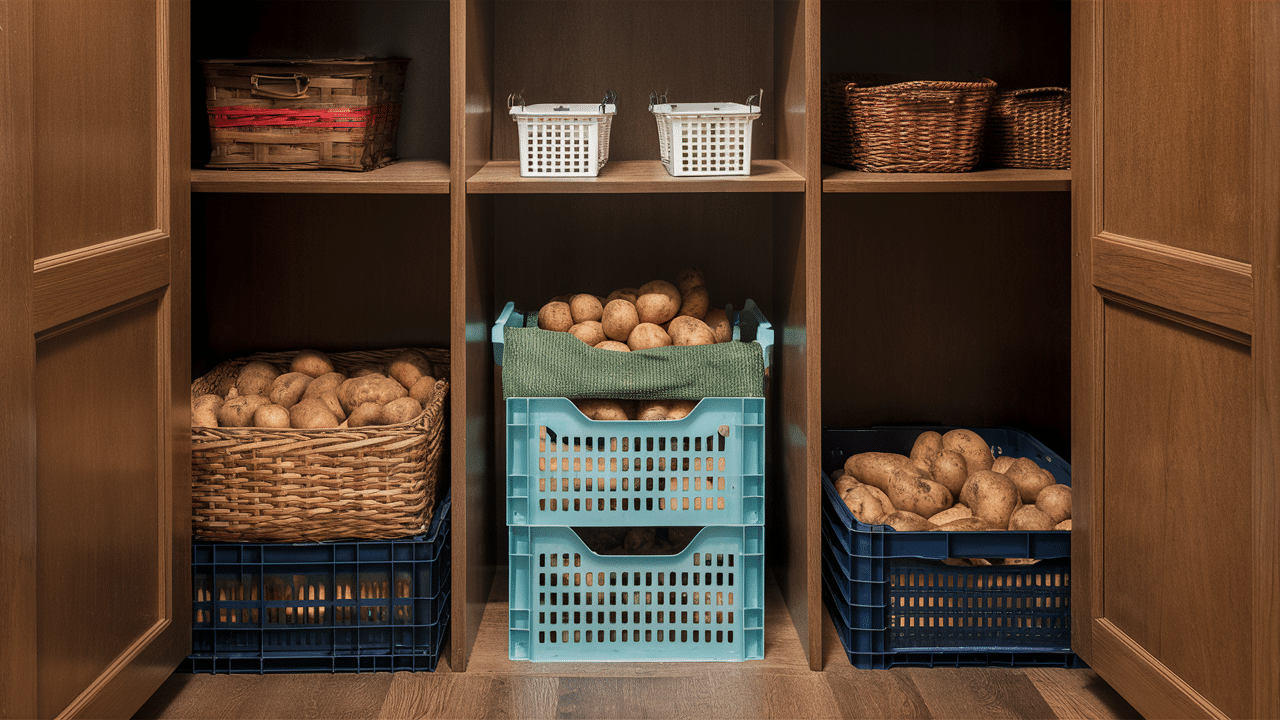
Not everyone has access to a traditional root cellar, but that doesn’t mean you can’t store potatoes for months.
Several practical methods work well in modern homes, allowing you to keep your potato supply fresh through winter and beyond.
These options can be adapted to fit different living situations and space limitations.
| Storage Method | How It Works | Best For | Expected Storage Life |
|---|---|---|---|
| Cool Cabinet | Store in paper bags in the coolest kitchen cabinet | Small amounts, apartment living | 1-2 months |
| Under-Bed Storage | Place in shallow boxes under unused beds | Medium amounts, limited space | 2-4 months |
| Closet Floor | Set boxes/bins on the floor of a cool closet | Medium amounts, no basement | 2-3 months |
| Rubbermaid Bins | Use bins with holes drilled for air flow | Larger harvests, easy organization | 3-4 months |
| Cardboard Boxes | Layer potatoes with newspaper in boxes | Budget option, good air flow | 2-3 months |
| Dehydrated Slices | Slice, blanch, and dehydrate completely | Very long storage, minimal space | 1-2 years |
Implementing Alternative Storage Methods
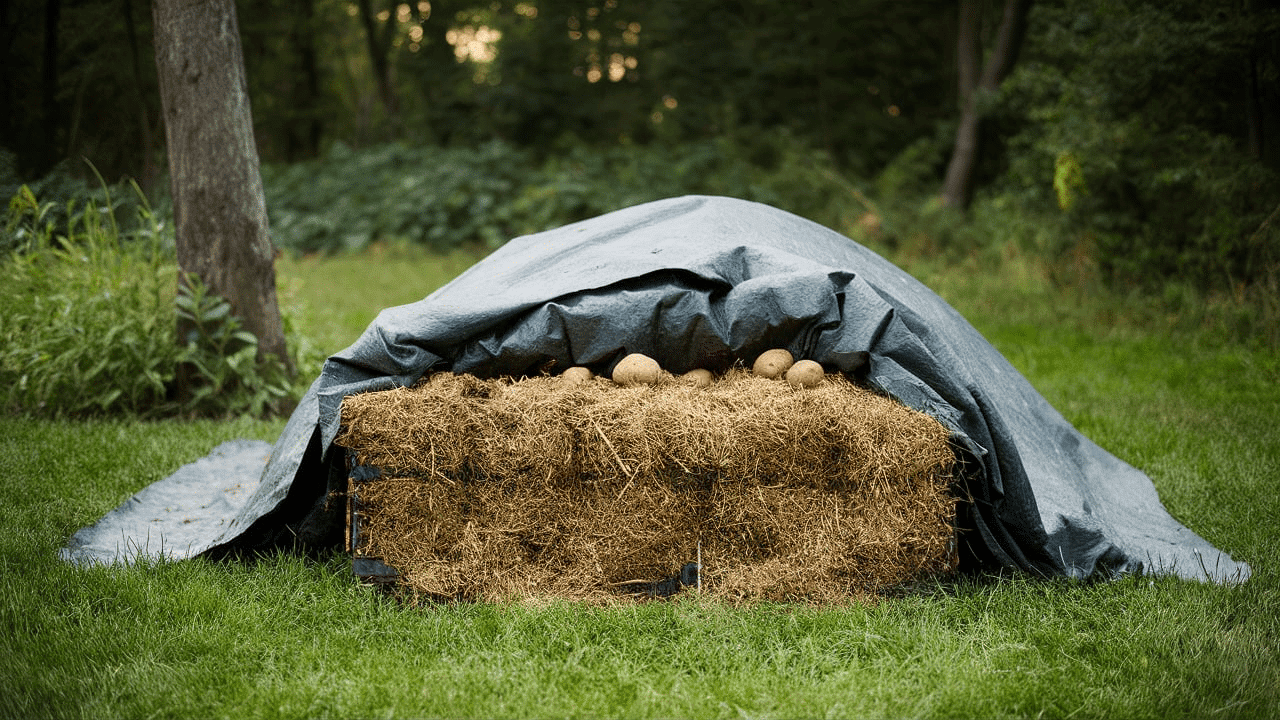
1. Use a Cool Closet or Pantry: If you don’t have a cellar, a dark, cool closet or pantry can work. Pick a spot that doesn’t get much heat, like under a staircase or in a back hallway. Be sure it stays between 45°F and 50°F and isn’t too dry.
2. Try a DIY Root Cellar Outside: If you live in a colder climate, you can build a simple root storage pit outside. Dig a hole below the frost line, line it with straw, and cover the potatoes with more straw and a tarp. This method has been used for generations and works well if done right.
3. Insulated Garage or Shed Storage: An unheated garage or garden shed can be a good spot if temperatures stay stable and don’t drop below freezing. To help keep the cold out, add some insulation, like foam boards or thick blankets, around your containers.
Regular Maintenance and Monitoring
Even after storing your potatoes the right way, you’ll still need to check on them from time to time. Potatoes can spoil slowly, and one bad one can affect the rest.
- Check Every Few Weeks: Look through your stored potatoes every 2 to 3 weeks. Watch for sprouting, soft spots, green patches, or mold. If you notice any issues, remove the problem potatoes right away.
- Remove and Rotate: Remove any spoiled potatoes to prevent them from affecting the rest. If your storage containers allow it, gently move the potatoes around to improve airflow. Use older or smaller potatoes first to avoid waste.
Conclusion
Storing potatoes the right way helps them last for months. Start by choosing the right kind, handling them gently, and letting them cure before storage. Please keep them in a cool, dark place with good airflow. Use bags or boxes that let air in, and avoid plastic.
Check your potatoes every few weeks and remove any that are soft or sprouting. One bad potato can ruin the rest. If you don’t have a good storage space, freezing, canning, or drying are great options, too.
With a little effort, you can enjoy fresh potatoes for months without them going to waste. It’s a great way to save time, money, and food.


